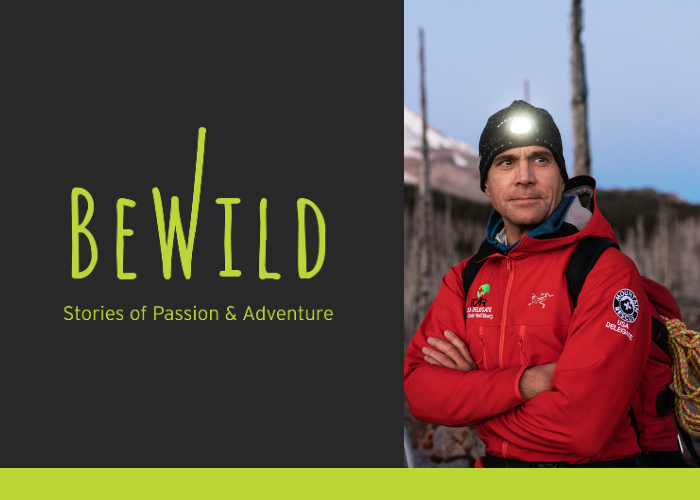
For more than 25 years, Christopher Van Tilburg has served as a volunteer with the Hood River Crag Rats – the nation’s oldest all-volunteer mountain rescue organization based on the slopes of Mount Hood, Oregon. As the Crag Rats recently marked their 100th anniversary, Van Tilburg turned a reflective eye to the team’s remarkable legacy in his newly released Mountaineers Books title, Crisis on Mount Hood.
On June 17, Van Tilburg will take the stage with moderator Lowell Skoog for a compelling conversation exploring the Crag Rats’ storied history, the writing journey behind Crisis on Mount Hood, and the evolving future of alpine search and rescue.
In anticipation of the event, we asked Van Tilburg to share insights from his decades of service – what he’s learned through volunteerism, his concerns for Mount Hood’s future, and advice for those interested in joining the vital work of mountain rescue. Here's what he had to say.
You’ve been volunteering with the Crag Rats for over 20 years, what inspired you to write Crisis on Mount Hood now?
CVT: Almost a decade ago, I was looking for another book to write and I had a ton of mountain rescue stories. Then I realized I turn 60 the same year Crag Rats turns 100. Because I’m fascinated with both the history and culture of the group that I’ve been a member of for 25 years and includes all my best friends, I decided to write the book for the 100 year anniversary of Crag Rats.
Has your work with the Crag Rats influenced your work as an emergency room physician? In what ways?
CVT: The most important lesson I learned from Crag Rats – one not taught in medical school – is that we have a priority for rescues: self, team, patient. We have to take care of ourselves first, because if we are not healthy, we become a liability and can’t function safely as a rescuer. For the same reasons, we take care of our team second – many times we have stopped or delayed rescues for situations that were unsafe to rescuers. And finally, as long as self and team are healthy and ready, we go for the subject. I apply these principles to my work in the emergency department, but also my home and family life too.
While Crisis on Mount Hood is focused on the history of Mount Hood specifically, what are some concerns facing Mount Hood that are shared throughout the rest of the Cascades Range (and beyond)?
CVT: I think Mount Hood is an indicator for the world: what we see on the world’s most climbed glaciated peak, is happening everywhere at various levels. And sometimes the impact is not from local influences, but how the world runs.
For folks interested in volunteering in search and rescue, what is your most valuable piece of advice?
CVT: Prospective members should have solid outdoor skills but don’t necessarily need rescue skills – we can teach rescue skills. But the most important piece to come to the table with is a willingness to get out of bed in the middle of the night, in the middle of a storm, when you have to be at work the next morning, and head into the wilderness to save someone: we can’t teach someone to have a passion for the mountains and a willingness to help people.
If you had to forecast into the future, what are some challenges you foresee for the upcoming summer seasons in the mountains?
CVT: Technology. People go deeper, farther, higher into the mountains with better climbing equipment and better navigation equipment. Similarly, we use advanced telecommunication techniques for rescues: cell phones, GPS locators, drones, aircraft radar, digital avalanche transceivers, electronica avalanche airbags, GPS enabled wristwatches. But these are complicated to master, rely on batteries, have electromagnetic interference, and sometimes don’t transmit or receive. So, we still have to rely on old-school skis-on-snow.
What is a lesson you’ve learned from your time with the Crag Rats that has surprised you?
CVT: One of the most valuable skills, and one I employ often, is not medical capability or technical rescue ability, but situational awareness and the ability to provide on-scene leadership. We are all “can do” people with willingness and skills to get tasks completed (technical rope raise, splint knee, hypothermia wrap) but it’s very difficult and essential for someone to stand back, not touch anything, and take command of a rescue operation.
BeWild Speaker Series
Crisis on Mount Hood: A Century of Courage and the Future of Mountain Safety
June 17, 2025 from 6:30-8:30pm
The Seattle Program Center
7700 Sand Point Way NE, Seattle, WA 98115
Tickets
General admission: $15
Mountaineers member admission: $12
Not yet a Mountaineers member? Sign up for a membership to save on Banff, MountainFilm, BeWild, and more! Plus, join a community of outdoor enthusiasts excited to join you on your next adventure.
 Hannah Abebe
Hannah Abebe
